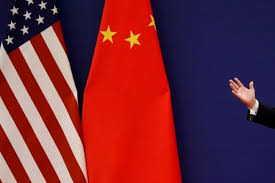U.S., China haggle over toughest issues in trade war talks

Top U.S. and Chinese trade negotiators haggled on Thursday over the details of a set of agreements aimed at ending their trade war, just one week before a Washington-imposed deadline for a deal expires and triggers higher U.S. tariffs.
Reuters reported exclusively on Wednesday that the two sides are starting to sketch out an agreement on structural issues, drafting language for six memorandums of understanding on proposed Chinese reforms.
If the two sides fail to reach an agreement by March 1, U.S. tariffs on $ 200 billion worth of Chinese imports are set to rise to 25 percent from 10 percent. Tit-for-tat tariffs between the world’s two largest economic powers have disrupted international trade and slowed the global economy since the trade war started seven months ago.
Negotiators have struggled this week to overcome differences on specific language to address tough U.S. demands for structural changes in China’s economy, two sources familiar with the talks said. The issues include an enforcement mechanism to ensure that China complies with any agreements.
“It’s not surprising that this week has been more challenging,” said an industry source familiar with the talks. “Once you move from putting together outlines to filling out the details, that is where things would naturally become more challenging.”
Chinese officials did not answer questions as they left the U.S. Trade Representative’s office on Thursday evening after more than nine hours of talks on Thursday.
The discussions began with a photo opportunity where U.S. Trade Representative Robert Lighthizer and Chinese Vice Premier Liu He faced each other silently across a table in the Eisenhower Executive Office Building next door to the White House.
It was unclear whether Liu would meet with U.S. President Donald Trump after the scheduled end of talks on Friday, as they did during Liu’s last visit to Washington for talks in late January.
Trump, who has embraced an “America First” policy as part of an effort to rebalance global trade, has said the March 1 deadline could be extended if enough progress is made.
Sources familiar with the negotiations told Reuters the memorandums would cover forced technology transfer and cyber theft, intellectual property rights, services, currency, agriculture and non-tariff barriers to trade.
The two sides remain far apart on demands by Trump’s administration for China to end practices on those issues that led Trump to start levying duties on Chinese imports in the first place.
Chinese President Xi Jinping would need to undertake difficult structural economic reforms to meet U.S. demands. The United States is offering no real concessions in return, other than to remove the tariff barriers Trump has imposed to force change from China.
For a FACTBOX on issues covered by the MOUs, see
PEN TO PAPER
One of Trump’s demands that is easier to fix for Beijing is to reduce the trade imbalance between the two nations. The U.S. trade deficit with China reached a record $ 382 billion through the first 11 months of 2018.
The two sides have reached consensus on how to alleviate the trade imbalances, several Chinese government sources said. Washington and Beijing are looking at a 10-item list for that, including additional Chinese purchases of agricultural produce, energy and goods such as semiconductors.
U.S. Agriculture Secretary Sonny Perdue called China’s pledges to purchase U.S. agricultural produce premature.
“Those proposals are all contingent upon a grand deal,” he said on the sidelines of the U.S. Department of Agriculture’s annual forum in Washington.
“The real issue is structural reforms regarding intellectual property, enforceability of those types of provisions.”
The United States could quickly recover its lost agricultural markets in China if a deal is struck, he said.
Perdue has overseen $ 12 billion in federal aid to U.S. farmers for losses they have sustained because of the trade war. China had all but halted purchases of U.S. soybeans, which were the single biggest U.S. agricultural export, worth around $ 12 billion in 2017.
